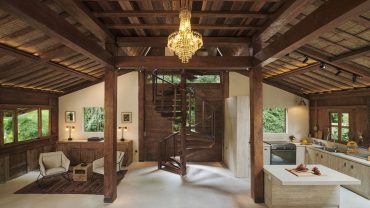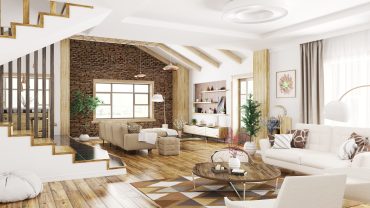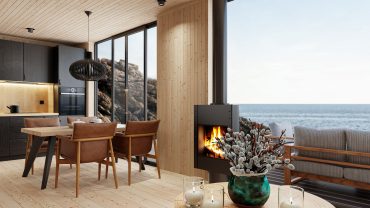At its heart, wabi sabi interior design is a concept that finds profound depth and significance in the natural ageing process, the textures and forms that emerge from wear and imperfection, and the serenity found in understated elegance.
Unlike the polished, pristine, and symmetrical standards often celebrated in mainstream design, wabi sabi interiors lean into the charm of asymmetry, the unrefined, and the quietly imperfect. It’s the reverence of the flawed. This design ethos can not only invite a visual and tactile richness into your space, but also encourages a mindset of mindfulness and appreciation for the perfectly imperfect aspects of our surroundings.
So whether you’re looking to adopt a more minimal lifestyle, or you have come to appreciate that the little nicks and chips on your kitchen chairs or a beloved vase are to be embraced rather than hidden, wabi sabi design might be for you.
A Short History of Wabi Sabi Interior Design

Ancient Japanese tea ceremony (Credit: Francesco Riccardo Iacomino via Getty Images)
The term wabi sabi itself is a confluence of two distinct ideas. Wabi refers to a comprehensive appreciation of simplicity and calmness, the concept of living alone in nature. Sabi, on the other hand, broadly translates as ‘lean’ or ‘withered’ and it denotes the beauty that comes with age – the patina of time. Together, they encapsulate a worldview that finds harmony and depth in the impermanent, the modest, and the aged.
The historical roots of wabi sabi design are as rich and textured as the philosophy itself. Emerging in Japan during the fifteenth and sixteenth centuries, it was initially intertwined with the tea ceremonies of Zen monk Sen no Rikyu that celebrated rusticity and austerity, contrasting sharply with the prevailing penchant for lavishness. He believed that the tea ceremony, and the atmosphere of the room and the objects found within it, were of equal importance.
Over the centuries, this ethos has woven itself into various aspects of Japanese culture, art, and design, profoundly influencing not only interior design but also pottery, fashion, and literature. It’s this storied background that lends wabi sabi interiors their depth, offering not just a design style but a way of seeing and experiencing the world that has the ability to enrich our daily lives.
What is Wabi Sabi Interior Design: The Key Principles

The serene and tranquil nature of wabi-sabi (Credit: sunnywinds via Getty Images)
The principles of wabi sabi design are focused on the textures and imperfections of natural materials, a muted colour palette invoking a sense of calm, and simplistic, balanced design motifs that respect and represent the natural world’s inherent irregularities.
Natural Materials

Natural materials in a wabi-sabi living room (Credit: Vasyl Cheipesh via Getty Images)
Wabi sabi decor fundamentally embraces organic, sustainable and natural materials like wood, stone, metal, leather, and clay. They’re chosen for their inherent beauty, texture, and the unique imperfections they develop over time, such as the ability to age, chip, stain, wear and rust. By incorporating these elements, your space will convey a sense of warmth and authenticity, fostering a deep connection with the natural world.
Colour Palette

Muted tones of wabi-sabi interior design (Credit: Vasyl Cheipesh via Getty Images)
The colour palette in wabi sabi design is deeply inspired by nature, favouring modest, earthy tones, including subtle shades of grey, green, orange, taupe, and brown. These subdued shades contribute to a tranquil and soothing atmosphere, reflecting the philosophy’s emphasis on simplicity and serenity. The use of natural dyes and pigments further underscores the commitment to organic authenticity.
Functionality & Comfort

A wabi-sabi interior space (Credit: Vasyl Cheipesh via Getty Images)
Wabi sabi interiors are as much about comfort and functionality as they are about aesthetics. Furniture and layouts are chosen not only for their visual appeal but for their practicality and the ease they bring to daily living. This principle ensures that spaces are not just beautiful but also livable and welcoming, creating a harmonious balance between form and function.
Furniture

Embracing the imperfections (Credit: Longhua Liao via Getty Images)
Furniture within wabi sabi interior design is chosen for its embodiment of natural beauty, simplicity, and the marks of time. Pieces are often made from natural materials like wood or bamboo and are chosen as much for their functional beauty as the story they tell through their craftsmanship, as well as their integration into space. The emphasis is on quality and sustainability, favouring items that age and wear gracefully and contribute to a sense of calm and comfort in the home.
The Irregularity of Art

Inherent beauty in broken ceramics (Credit: Billie Bond via Getty Images)
Artistic pieces and handcrafted elements play a crucial role in wabi sabi interior design. These items, often artisanal or handcrafted, carry the marks of their makers, adding depth and character to the space. They celebrate the human touch, with irregularities and imperfections seen as marks of beauty and individuality.
The Natural World

Elements of nature in wabi-sabi (Credit: Navamin keawmorakot via Getty Images)
Incorporating elements of the natural world is a hallmark of wabi sabi decor. This includes plants and water features, utilising natural light, or choosing artworks and decorations that depict natural scenes. These elements help to blur the boundaries between indoors and outdoors, reinforcing the philosophy’s grounding in nature.
Aesthetic Beauty

Wabi-sabi interior design (Credit: Navamin keawmorakot via Getty Images)
Most fundamentally, wabi sabi design finds aesthetic beauty in imperfection, impermanence and incompletion. This principle eschews the conventional ideals of symmetry and flawlessness, instead celebrating the marks of wear and the unique stories objects tell over time. It’s a reminder that beauty can be found in the overlooked and the mundane.
Perfectly Imperfect: Wabi Sabi Interior Design

Wabi sabi interior style (Credit: FollowTheFlow via Getty Images)
Wabi sabi design offers a profound philosophy that celebrates the beauty of imperfection, the passage of time, and the inherent qualities of the natural world. By embracing simplicity, functionality, and the authenticity of natural materials and craftsmanship, this design approach creates spaces that resonate with tranquillity, warmth, and personal significance.












